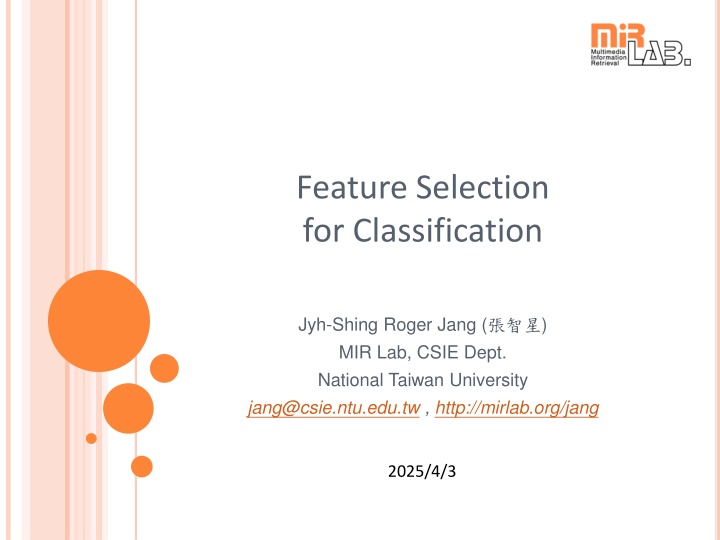
Effective Feature Selection Techniques for Classification Tasks
Learn about feature selection techniques like heuristic search, one-pass ranking, and more for improving accuracy, reducing computation, and enhancing explainability in classification tasks. Explore examples and comparisons between feature selection and extraction methods.
Download Presentation

Please find below an Image/Link to download the presentation.
The content on the website is provided AS IS for your information and personal use only. It may not be sold, licensed, or shared on other websites without obtaining consent from the author. If you encounter any issues during the download, it is possible that the publisher has removed the file from their server.
You are allowed to download the files provided on this website for personal or commercial use, subject to the condition that they are used lawfully. All files are the property of their respective owners.
The content on the website is provided AS IS for your information and personal use only. It may not be sold, licensed, or shared on other websites without obtaining consent from the author.
E N D
Presentation Transcript
Feature Selection for Classification Jyh-Shing Roger Jang ( ) MIR Lab, CSIE Dept. National Taiwan University jang@csie.ntu.edu.tw , http://mirlab.org/jang 2025/4/3
Outlines Introduction to feature selection Heuristic search One-pass ranking Sequential forward selection Exhaustive search Examples 2/14
Intro. to Feature Selection Feature selection Also known as input selection Goal To select a subset from the original feature set for better accuracy Items to be specified before feature selection Classifier, such as KNNC Performance index, such as accuracy Performance evaluation method, such as k-fold CV Benefits Better accuracy Less computation Explainability between features and outputs Quiz! 3/14
Feature Selection vs. Extraction Common part Both known collectively as dimensionality reduction Goal: Reduced model complexity with improved accuracy Feature selection: select the best subset from the original features Feature extraction: Extract new features by a linear or nonlinear combination of all original features Extracted features may not have physical meanings Examples of linear feature extraction PCA (unsupervised) LDA (supervised) 4/14
Heuristic Search A number of heuristic search for feature selection One-pass ranking Sequential forward selection (SFS) Sequential backward selection (SBS) Generalized sequential forward selection Select the best k features at each iteration (k=1 for SFS) Generalized sequential backward selection Delete the best k features at each iteration (k=1 for SBS) Sequential forward floating selection (SFFS) Sequential backward floating selection (SBFS) Add m, remove n selection Generalized add m, remove n selection 5/14
One-pass Ranking Steps Sort the given d features in descending order of their accuracy based on a single feature only Select the top m features from the sorted list that has the best performance Complexity Quiz! If the dataset has d features, we need to perform 2d-1 CV. Properties Quiz! Advantage: Extremely fast Disadvantage: Feature correlation is not considered Selected features are not always optimal 6/14
Example of One-Pass Ranking One-pass ranking with 5 features Original order x2 x1 x3 x4 x5 After ranking x3 x1 x5 x4 x2 7/14
Sequential Forward Selection (SFS) Steps for sequential forward selection Select the first feature that has the best accuracy. Select the next feature (among all unselected features) that, together with the selected features, gives the best accuracy. Repeat the previous step until all features are selected. 1. 2. 3. Complexity Quiz! If the dataset has d features, we need to perform d(d+1)/2 CV. Properties Quiz! Advantage: Fast Disadvantage: Selected features are not always optimal. 8/14
Example of SFS SFS with 4 features One-pass Ranking 1 input x1 x2 x3 x4 x5 2 inputs x2, x1 x2, x3 x2, x4 x2, x5 3 inputs x2, x4, x1 x2, x4, x3 x2, x4, x5 4 inputs x2, x4, x3, x1 x2, x4, x3, x5 ... 9/14
? features 2? 1 CV procedures for perf. evaluation Exhaustive Search Steps for exhaustive search (ES) Generate all combinations of features and evaluate them one-by-one Select the feature combination that has the best accuracy. 1. 2. Drawback d features 2d-1 CV for performance evaluation d = 10 1023 CV for evaluation Time consuming! Quiz! Properties Advantage: Optimal feature set can be identified. Disadvantage: Extremely slow if no. of features is large. 10/14
Exhaustive Search Direct exhaustive search One-pass Ranking 1 input x1 x2 x3 x4 x5 2 inputs x1, x2 x1, x3 x1, x4 x1, x5 x2, x3 ... 3 inputs x1, x2, x3 x1, x2, x4 x1, x2, x5 x1, x3, x4 ... 4 inputs x1, x2, x3, x4 x1, x2, x3, x5 x1, x2, x4, x5 ... ... 11/14
Summary of Computational Complexity Quiz! No. of CV required for feature selection in a dataset of d features One-pass ranking 2d-1 Sequential forward selection d(d+1)/2 Sequential backward selection d(d+1)/2 Exhaustive search 2d-1 No. of CV required for selecting up to m features in a dataset of d features One-pass ranking d+m-1 Sequential forward selection ??? Sequential backward selection ??? Exhaustive search ??? 12/14
Feature Selection for Iris Dataset SFS Exhaustive search 13/14
Feature Selection for Wine Dataset SFS SFS with input normalization Summary SFS 3 selected features, LOO accuracy=93.8% SFS with feature normalization 6 selected features, LOO accuracy=97.8% ES with feature normalization 8 selected features, LOO accuracy=99.4% 14/14
Proper Use of Feature Selection Common use of feature selection Increase model complexity sequentially by adding more features Select the model that has the least validation error Typical curve of error vs. model complexity Determine the model s complexity with the least validation error Validation error Training error Error rate Optimal structure Model complexity (# of selected inputs) 15/14
